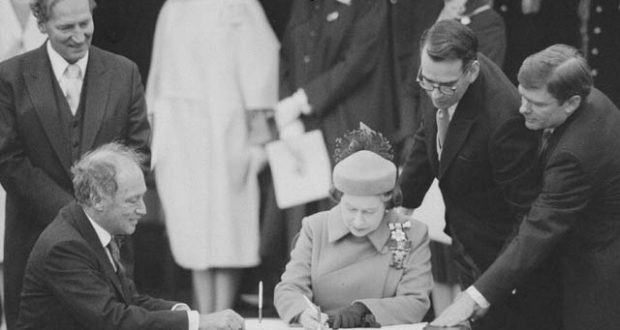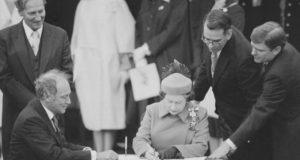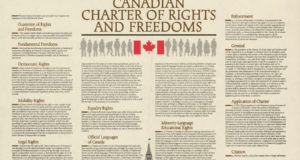Summer is fast approaching and, in keeping with that season’s custom (though not yet a convention), I thought it best to engage Leonid Sirota in constitutional debate. Last year, we went a few rounds on section 7 of the Charter. This year, the hot topic is s.33 of the Charter, otherwise known as the “notwithstanding clause,” which states that Parliament or the legislature of a province may declare that a law continues to operate “notwithstanding” certain Charter provisions.
Professor Sirota has written three separate pieces on the notwithstanding clause, and, more particularly, the decision of the Saskatchewan Court of Queen’s Bench in Good Spirit School Division No. 204 v Christ the Teacher Roman Catholic Separate School Division and the subsequent announcement by Premier Wall that the Saskatchewan legislature would invoke the notwithstanding clause. Professor Sirota’s posts are eloquently written and persuasively argued. That much is par for the course. But, as Professor Sirota has said in regard to my own constitutional arguments, his position is mostly wrong.
Each of Professor Sirota’s posts makes a separate argument. In “No Money for You,” he argues that the court in Good Spirit got it right in finding that provincial funding for non-Catholics attending Catholic schools was unconstitutional. In “Notwithstanding Scrutiny,” he argues that Premier Wall has not justified his intention to use the notwithstanding clause. In “Chekhov’s Gun,” Professor Sirota goes further and suggests that the notwithstanding clause is incompatible with judicially enforceable rights. In this post, I will tackle each of these arguments, beginning with the first and then dealing with the second and third together. I will argue that the Court’s decision in Good Spirit was fallacious and that the decision left the Government of Saskatchewan in an untenable position where its only reasonable option was to invoke the notwithstanding clause.
I. The Court’s Decision in Good Spirit
I should begin by conceding that I claim no special expertise when it comes to s.93 of the Constitution Act, 1867 or any provision of the Saskatchewan Act, including s.17. Professor Dwight Newman has noted in an op-ed in the National Post that Justice Layh was not presented a robust evidentiary record and did the best he could with the “mess” that was before him. Of that I have no doubt, and Justice Layh’s lengthy decision is nothing if not carefully reasoned and eminently doctrinal. Justice Layh’s conclusion that the funding of non-Catholics would not amount to a protected “denomination aspect” under s.93 of the Constitution Act strikes me as perhaps an overly strict reading, but definitely plausible. It could certainly be argued that in certain communities Catholic schools could not practically operate without the attendance of non-Catholics, but that is an evidentiary issue, so let’s leave it at that.
My real problem with the decision is the Charter analysis. Justice Layh’s decision rests on the principle of “religious neutrality.” He correctly points out that this value is nowhere to be found in the text of the Charter itself, but has rather been developed by the judiciary. Religious neutrality is an important concept, but I know of no decision where the Supreme Court has said that it is absolute. In fact, the Court has said the opposite – that “absolute neutrality does not exist” (see S.L. v Commission scolaire des Chênes at para. 31). Justice Layh’s decision, however, treats religious neutrality as if it were an absolute, and takes the concept well beyond what could plausibly be inferred from the constitutional text.
The logic of the decision is that by funding non-Catholics attending Catholic schools, the state is privileging Catholics as they are able to proselytize their faith to a greater degree than other faiths (since those faith groups do not receive funding for non-members to attend their schools). However, if the state deprived non-Catholics of funding to attend Catholic schools, could that class of students not argue – persuasively – that they were the victims of discrimination? Indeed, if Justice Layh’s decision were enforced, non-Catholics would effectively be forced to attend secular schools, while Catholics would have a taxpayer funded choice to attend either Catholic or secular schools. The government, in other words, would confer a benefit upon one class of people to the exclusion of all others solely on the basis of religion. This is the very essence of religious discrimination.
Indeed, the government would be left with only two ways of negating this discrimination. It could force Catholics to pay to attend secular schools, which would comport with the Court’s extreme definition of “religious neutrality” and place everyone on equal footing. This solution, however, would naturally give rise to other pressing Charter and policy issues, chief among them being that it would have the effect of segregating Catholics. Alternatively, the government could provide equal funding to all religious schools, but this would prove far too costly. The Charter is by and large a “negative rights” document and the government should not have to break the bank to comply with its provisions.
Good Spirit also raises privacy and religious freedom concerns. The implication of the decision is that individuals must undergo a sort of “religious screening” when they apply to a Catholic school. How else is the government to determine who is a true Catholic deserving of funding? This raises a whole host of philosophical, legal and practical concerns that are too numerous to discuss in a single post. Suffice it to say, there is something deeply troubling about the state investigating the religious bona fides of the citizenry. To suggest that the Charter would permit such a practice is almost certainly wrong. To suggest the Charter actually demands it is nothing short of absurd.
It is also questionable whether providing funding for non-Catholics to attend Catholic schools results in any tangible harm to other religious institutions. It stands to reason that even if non-Catholics were required to pay to attend Catholic schools, tuition would be far cheaper than at other religious schools, since the fixed operating expenses of Catholic schools would still be covered by the government. Catholic schools would therefore still be in a relatively advantageous position to proselytize their faith to non-believers. To the extent that non-Catholic religious institutions are further disadvantaged by providing funding for non-Catholics to attend Catholic schools, that nominal increase in harm seems trifling in comparison to the real discrimination every non-Catholic in the country would suffer as a result of the Court’s decision.
In sum, providing funding for non-Catholics to attend Catholic schools is not constitutionally prohibited; if anything, it is constitutionally required. The principle of religious neutrality should not be taken so far that it undermines the ordinary and historical meaning of religious freedom and equality enshrined in the Charter.
II. Invoking The Notwithstanding Clause
Professor Sirota takes the view that the Court in Good Spirit got it right. However, I suspect he would argue that even if the decision is wrong, this would still not justify invoking the notwithstanding clause. Professor Sirota raises some valid arguments about the danger inherent in relying upon the notwithstanding clause, and I am by no means prepared to argue that it should be invoked casually whenever a government finds the court’s decision to be inconvenient. However, as I intend to argue, the notwithstanding clause is a legitimate provision of the Constitution and invoking it in certain circumstances, including in response to the Good Spirit decision, is entirely appropriate.
The Notwithstanding Clause is Legitimate
The historical record is clear that the notwithstanding clause was an essential part of the constitutional bargain struck in 1982 that resulted in the patriation of our Constitution and the adoption of a constitutional bill of rights. Many on both the left and the right were opposed to uprooting Canada’s tradition of parliamentary supremacy. Without the notwithstanding clause, the already wary premiers would never have signed on to the Charter. Andrew Coyne has argued if Pierre Trudeau had gone to the people directly in a referendum, the Charter would have been adopted without a notwithstanding clause. He may be right, but there is no way to know. As recent geopolitical events make clear, national referenda do not always go the way we expect. More importantly, the referendum would not have been legally binding. Trudeau would have still required substantial provincial consent to obtain a constitutional amendment from the UK Parliament. So, while the Gang of Eight was certainly moved to strike a deal, so too was Trudeau. The salient fact is that the Charter would never have been adopted without the notwithstanding clause.
Professor Sirota appears to acknowledge that the notwithstanding clause was essential to the constitutional bargain of 1982, but argues that its necessity at the time of patriation does not justify its use today. To this end, he likens the notwithstanding clause to the federal power to “disallow” provincial legislation, which, he argues, was crucial to the 1867 compromise, but which is no longer a legitimate power due to the development of a constitutional convention against its use. While he does not expressly make this point, my sense is that he would support a constitutional convention against using the notwithstanding clause.
To begin, I am not sure that there is anything more than a custom against using the disallowance power. This raises broader issues over whether an unwritten convention can ever supersede written law and whether a validly enacted statutory or constitutional provision can fall into desuetude. But for argument’s sake, let us accept that there is a firm constitutional convention against the disallowance power. In my view, it is of no significance. The disallowance power is in no way analogous to the notwithstanding clause. As historian Paul Romney has argued, disallowance was incorporated into the Constitution because it was an age-old Crown power and one that had rarely been exercised. Oliver Mowat, one of the Fathers of Confederation and later the premier of Ontario, argued following the federal disallowance of Ontario’s Rivers and Streams Act that the Fathers had agreed at Quebec that the power “should not be used except within the limits in which the Imperial veto had theretofore been exercised.” In other words, it was a power intended to be used in only the most extraordinary circumstances. This understanding was echoed during the Confederation debates. One legislator referred to the power as “extreme” and “almost revolutionary,” while another skeptically summarized the Fathers’ assurances that the disallowance power “is to be possessed by [the federal government], but never exercised” (see Janet Ajzenstat et al., Canada’s Founding Debates, pp. 291 & 308).
In many ways, the disallowance power is the very antithesis of the notwithstanding clause. Whereas the disallowance power was an old colonial relic, the notwithstanding clause was a uniquely Canadian invention. Whereas the disallowance power made the individual colonies (the future provinces) more skeptical of joining the union, the notwithstanding clause was the carrot that brought the majority of the provinces on board in 1982. Whereas the disallowance power was incorporated with the express understanding that it was not to be used save for exceptional circumstances, the notwithstanding clause was incorporated with the express understanding that it would safeguard legislative choice and provincial autonomy.
Professor Sirota sees the nub of the issue as being whether we want a judicially enforced constitution or Parliamentary sovereignty. I believe it is a bit more nuanced than that. The notwithstanding clause is not a ‘get out of jail free card’ for governments that run roughshod over their constitutional obligations. As Gerard Kennedy pointed out in his recent post for ARL, the invocation of the notwithstanding clause must be renewed every five years. This will necessarily draw political attention and debate to the issue. Whether or not to renew an invocation could even form a major election issue. Invoking the clause is a risky political gambit and Brad Wall’s self-assured decision to do so in the case of Good Spirit won’t change that fact. In the end, the vast majority of Charter decisions will be made solely by the judicial branch. What the notwithstanding clause ensures is not legislative supremacy, but legislative inclusion. It recognizes, to quote Justice Stratas of the Federal Court of Appeal, that “[o]ther branches of government are interpreters of the Constitution.”
What the debate really boils down to is not judicial supremacy vs. legislative supremacy, but rather the nature of rights: are rights abstract a priori things that judges can discern from the laws of nature, or are they more organic, more intangible, and derived from political society? This question divided the American colonists in 1776, but Canada’s Fathers of Confederation mostly adopted the latter view, and that view has continued to infuse Canadian political culture ever since. The Charter as a whole represented a turn toward the American model, but several of its provisions, including, but not limited to, the notwithstanding clause, ensured a continuity with our historical roots. The Charter thus brought an American-style bill of rights, without importing an American-style conception of rights.
Saskatchewan’s Intention to Use the Notwithstanding Clause is Justified
If we accept that the notwithstanding clause is a legitimate part of the Canadian Constitution, it admittedly does not follow that the government of Saskatchewan’s stated intention to use the clause in the case of Good Spirit was correct. Professor Sirota argues in “Notwithstanding Scrutiny” that the government’s intention to invoke the clause in this particular case was unjustified as the government defended its decision on the basis of “school choice,” and not on the grounds that it disagreed with the Court’s interpretation of the Charter.
I must say I do share some of Professor Sirota’s concerns. As discussed above, the justification for the notwithstanding clause lies in the historic Canadian conception of rights. The clause should therefore only be invoked when the government disagrees with the Court’s interpretation of rights. It should not be invoked simply because the government finds the Court’s decision to be inconvenient.
On the other hand, we should not expect the premier to provide the public and the media with a thoughtful meditation on the limits to constitutional rights during a brief press announcement. Implicit in Wall’s announcement is that any infringement of the Charter was properly justified under s.1. To be sure, this can and should be fleshed out in greater detail over time. The Saskatchewan legislature will have to debate this issue eventually and those debates should take on a constitutional character. It may be that the legislature will ultimately decide that the issue is not about the interpretation of freedom and equality of religion, but rather about whether its policy constituted a “reasonable limit” of those rights. But, whatever the case, the legislature should make explicit why it believes the Court’s decision was not only problematic from a policy perspective, but wrong as a matter of constitutional law.
This raises a more general question: when should the legislative branch invoke the notwithstanding clause? What criteria, in other words, must the legislature meet for the use to be politically legitimate? My own view is that there are two overriding factors to consider. First and foremost, the legislature must offer a plausible basis for the position that the Court’s decision was wrong. Second, the government should appeal the decision concurrently with its announcement to invoke the clause. It is one thing for the legislature to disagree with the opinion of a single lower court judge. But if 12 appeal judges (3 on the Court of Appeal and 9 on the Supreme Court) are unanimous that the original decision was correct, the justification for invoking the clause becomes far more problematic. Conversely, where the appeal court disagrees with the lower court’s decision, or the appellate justices are divided on the issue, the use of the clause will garner greater legitimacy.
While the Saskatchewan legislature and government have not yet satisfied these factors, I believe there is ample basis for them to do so, for the reasons outlined above. The Court’s decision in Good Spirit left the government of Saskatchewan in an untenable position. It could either start vetting students based on religion, or opt to fund every single religious educational institution in the province, the costs of which would be utterly prohibitive. The decision to invoke the notwithstanding clause was the only sensible alternative. Premier Wall should also signal his government’s intention to appeal the decision. The government clearly did not exhaust the available legal arguments at the Court of Queen’s Bench, and a more robust constitutional argument could result in the decision being overturned at the Court of Appeal or the Supreme Court, which would provide the government with finality on the issue and also provide additional justification for invoking the clause in the interim.
Conclusion
Professor Sirota has warned against “playing favourites” with constitutional provisions, but, with respect, he seems to have fallen victim to this very affliction. Section 33 should not be treated as the Charter‘s embarrassing uncle, less still as the “nuclear option.” The historical record is clear that the notwithstanding clause was an essential component of the patriation of the Constitution and the enactment of the Charter in 1982. It is no less legitimate than any other constitutional provision.
Premier Wall has signaled an intention to invoke the clause in response to a decision that rests on sophistic reasoning, and that would leave the rights and freedoms of Canadians worse off. While he has not yet provided a comprehensive constitutional justification for invoking the clause, Premier Wall has taken the brave first steps toward breaking a foolish taboo and returning our nation’s conception of rights to their historic roots. For that, he should be applauded.
 Advocates for the Rule of Law
Advocates for the Rule of Law



